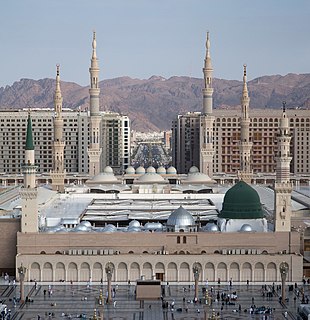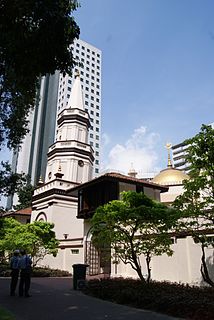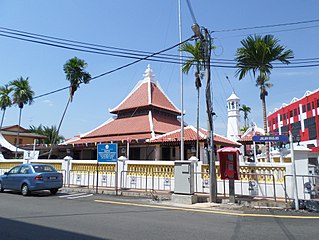
The Faisal Mosque is a mosque located in Islamabad, Pakistan. It is the fifth-largest mosque in the world and the largest within South Asia, located on the foothills of Margalla Hills in Pakistan's capital city of Islamabad. The mosque features a contemporary design consisting of eight sides of concrete shell and is inspired by the design of a typical Bedouin tent.

Al-Masjid an-Nabawi, known in English as The Prophet's Mosque, and also known as Al Haram, Al Haram Al Madani and Al Haram Al Nabawi by locals, is a mosque built by the Islamic prophet Muhammad in the city of Medina in the Al Madinah Province of Saudi Arabia. It was the second mosque built by Muhammad in Medina, after Masjid Quba'a, and is now one of the largest mosques in the world. It is the second holiest site in Islam, after the Masjid al-Haram in Mecca. It is generally open regardless of date or time, and has only been closed to visitors once in modern times, as Ramadan approached during the 2020 COVID-19 pandemic.
The Memon ethnic group originated in the Northwestern part of ancient India, currently the Sindh region of modern-day Pakistan. The majority of the Memon people around the world follow the Hanafi fiqh of Sunni Islam. The Memon people have cultural similarities with the Khoja, Khatri (Vohra), and Gujarati peoples. Memon people speak the Memoni language as their first language. Some consider the Memon language to be a dialect of the Sindhi language. The Memon language shares vocabulary with the Sindhi language, Kutchi language and Gujarati language. Today, the Memon people are connected through globally recognized organisations such as the World Memon Organisation (WMO) and International Memon orgnisation (IMO). Sindhi Memons and Kutchi Memons are related ethnic groups.

The Quba Mosque is a mosque located on the outskirts of Medina, Saudi Arabia. Initially, the mosque was built 6 kilometres off Medina in the village of Quba, before Medina expanded to include this village. Depending on whether the Mosque of the Companions in the Eritrean city of Massawa is older or not, it may be the first mosque in the world that dates to the lifetime of Muhammad in the 7th century CE. According to records, its first stones were positioned by Muhammad as soon as he arrived on his emigration from the city of Mecca to Medina, and the mosque was completed by his companions. Muhammad spent 14 days in this mosque praying qaṣr while waiting for Ali to arrive in Medina, after the latter stayed behind in Mecca to safeguard Muhammad’s life and safe escape by sleeping in Muhammad’s bed in his place, an event referred to in the Quran, sura al Baqara verse 207. Also going along with traditional saying, this mosque is said to be where the first Friday prayer was held, led by Muhammad.

Istiqlal Mosque in Jakarta, Indonesia is the largest mosque in Southeast Asia and the sixth largest mosque in the world in terms of worshipper capacity. Built to commemorate Indonesian independence, this national mosque of Indonesia was named "Istiqlal", an Arabic word for "independence". The mosque was opened to the public on 22 February 1978. Within Jakarta, the mosque is positioned next to Merdeka Square and the Jakarta Cathedral.

Mughal architecture is the type of Indo-Islamic architecture developed by the Mughals in the 16th, 17th and 18th centuries throughout the ever-changing extent of their empire in the Indian subcontinent. It developed the styles of earlier Muslim dynasties in India as an amalgam of Islamic, Persian, Turkic and Indian architecture. Mughal buildings have a uniform pattern of structure and character, including large bulbous domes, slender minarets at the corners, massive halls, large vaulted gateways, and delicate ornamentation; Examples of the style can be found in modern-day India, Afghanistan, Bangladesh, and Pakistan.

The Hajjah Fatimah Mosque is a mosque located along Beach Road in the Kampong Glam district within the Kallang Planning Area in Singapore. The mosque was designed in a mix of Islamic and European architectural styles, and completed in 1846. The mosque is named after an aristocratic Malay lady, Hajjah Fatimah, who commissioned its construction.

Indo-Islamic architecture is the architecture of the Indian subcontinent produced by and for Islamic patrons and purposes. Despite an initial Arab presence in Sindh, the development of Indo-Islamic architecture began in earnest with the establishment of Delhi as the capital of the Ghurid dynasty in 1193. Succeeding the Ghurids was the Delhi Sultanate, a series of Central Asian dynasties that consolidated much of North India, and later the Mughal Empire by the 15th century. Both of these dynasties introduced Persianate architecture and art styles from Western Eurasia into the Indian subcontinent.
Kutchi Memons, also spelled as Cutchi Memons, are an ethnic group or caste from Kutch in Gujarat, India, who speak the Kutchi language. They are related to the Memons associated with the historic state of Kathiwar, a Muslim community of Pakistan and India, who speak the Memon language.

Kampung Hulu Mosque is a mosque in Malacca City, Malacca, Malaysia. It is the oldest mosque in Malacca and among the oldest in the country.

Kampong Kling Mosque is an old mosque in Malacca City, Malacca, Malaysia.

The architecture of Bengal, which comprises the modern country of Bangladesh and the Indian states of West Bengal, Tripura and Assam's Barak Valley, has a long and rich history, blending indigenous elements from the Indian subcontinent, with influences from different parts of the world. Bengali architecture includes ancient urban architecture, religious architecture, rural vernacular architecture, colonial townhouses and country houses and modern urban styles. The bungalow style is a notable architectural export of Bengal. The corner towers of Bengali religious buildings were replicated in medieval Southeast Asia. Bengali curved roofs, suitable for the very heavy rains, were adopted into a distinct local style of Indo-Islamic architecture, and used decoratively elsewhere in north India in Mughal architecture.

The Abdul Gaffoor Mosque is a mosque in Little India, Singapore. It is located at Dunlop Street in the Rochor Planning Area.
Mosques in Kolkata refers to mosques in the city of Kolkata, in India.

The Badshahi Mosque is a Mughal era mosque in Lahore, capital of the Pakistani province of Punjab, Pakistan. The mosque is located west of Lahore Fort along the outskirts of the Walled City of Lahore, and is widely considered to be one of Lahore's most iconic landmarks.

There are eleven different types of buildings at the UNESCO-protected Champaner-Pavagadh Archaeological Park in Gujarat, India, including mosques, temples, granaries, tombs, wells, walls, and terraces. The monuments are situated at the foot of and around the Pavagadh Hill. The Baroda Heritage Trust lists 114 monuments in the area, of which only 39 are maintained by the Archaeological Survey of India, due to limited funding. The Forest Department owns 94% of the land here, while the temple trusts and other sectarian establishments provide facilities for boarding and lodging to pilgrims and tourists. On the southern side near the foot of the hill some dilapidated houses and the foundations of Jain temples can also be seen.

Kasunyatan Mosque is a small mosque in Kasunyatan village, Banten, Indonesia. Established between 1570 and 1596 it is one of the oldest mosques in Indonesia. The mosque is located in close proximity to the ruins of Old Banten, and functioned as a 16th-century center of Islamic learning in Banten. The mosque received a heritage status during the Dutch colonial period in 1932. Its status today is unknown.

The Grand Mosque of Bandung, previously known as the Great Mosque of Bandung, is a mosque in Bandung, the provincial capital of West Java, Indonesia. The mosque received the status of provincial mosque of West Java Province in 2004. It is located on the east side of the alun-alun of Bandung.

Adhai Din Ka Jhonpra is a large and imposing structure in the city of Ajmer in Rajasthan, India. It is one of the oldest mosques in India, and the oldest surviving monument in Ajmer.

Jamek Mosque, officially Sultan Abdul Samad Jamek Mosque is one of the oldest mosques in Kuala Lumpur, Malaysia. It is located at the confluence of the Klang and Gombak River and may be accessed via Jalan Tun Perak. The mosque was designed by Arthur Benison Hubback, and built in 1909.


























